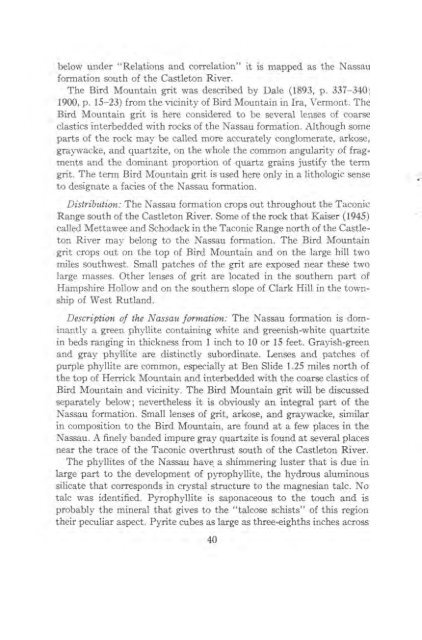STRATIGRAPHY AND STRUCTURE CASTLETON AREA VERMONT
STRATIGRAPHY AND STRUCTURE CASTLETON AREA VERMONT
STRATIGRAPHY AND STRUCTURE CASTLETON AREA VERMONT
You also want an ePaper? Increase the reach of your titles
YUMPU automatically turns print PDFs into web optimized ePapers that Google loves.
elow under "Relations and correlation" it is mapped as the Nassau<br />
formation south of the Castleton River.<br />
The Bird Mountain grit was described by Dale (1893, P. 337-340;<br />
1900, p. 15-23) from the vicinity of Bird Mountain in Ira, Vermont. The<br />
Bird Mountain grit is here considered to be several lenses of coarse<br />
clastics interbedded with rocks of the Nassau formation. Although some<br />
parts of the rock may be called more accurately conglomerate, arkose,<br />
graywacke, and quartzite, on the whole the common angularity of fragments<br />
and the dominant proportion of quartz grains justify the term<br />
grit. The term Bird Mountain grit is used here only in a lithologic sense<br />
to designate a facies of the Nassau formation.<br />
Distribution: The Nassau formation crops out throughout the Taconic<br />
Range south of the Castleton River. Some of the rock that Kaiser (1945)<br />
called Mettawee and Schodack in the Taconic Range north of the Castleton<br />
River may belong to the Nassau formation. The Bird Mountain<br />
grit crops out on the top of Bird Mountain and on the large hill two<br />
miles southwest. Small patches of the grit are exposed near these two<br />
large masses. Other lenses of grit are located in the southern part of<br />
Hampshire Hollow and on the southern slope of Clark Hill in the township<br />
of West Rutland.<br />
Description of the Nassau formation: The Nassau formation is dominantly<br />
a green phyllite containing white and greenish-white quartzite<br />
in beds ranging in thickness from 1 inch to 10 or 15 feet. Grayish-green<br />
and gray phyllite are distinctly subordinate. Lenses and patches of<br />
purple phyllite are common, especially at Ben Slide 1.25 miles north of<br />
the top of Herrick Mountain and interbedded with the coarse clastics of<br />
Bird Mountain and vicinity. The Bird Mountain grit will be discussed<br />
separately below; nevertheless it is obviously an integral part of the<br />
Nassau formation. Small lenses of grit, arkose, and graywacke, similar<br />
in composition to the Bird Mountain, are found at a few places in the<br />
Nassau. A finely banded impure gray quartzite is found at several places<br />
near the trace of the Taconic overthrust south of the Castleton River.<br />
The phyllites of the Nassau have a shimmering luster that is due in<br />
large part to the development of pyrophyllite, the hydrous alu.rninous<br />
silicate that corresponds in crystal structure to the magnesian talc. No<br />
talc was identified. Pyrophyllite is saponaceous to the touch and is<br />
probably the mineral that gives to the "talcose schists" of this region<br />
their peculiar aspect. Pyrite cubes as large as three-eighths inches across<br />
40













